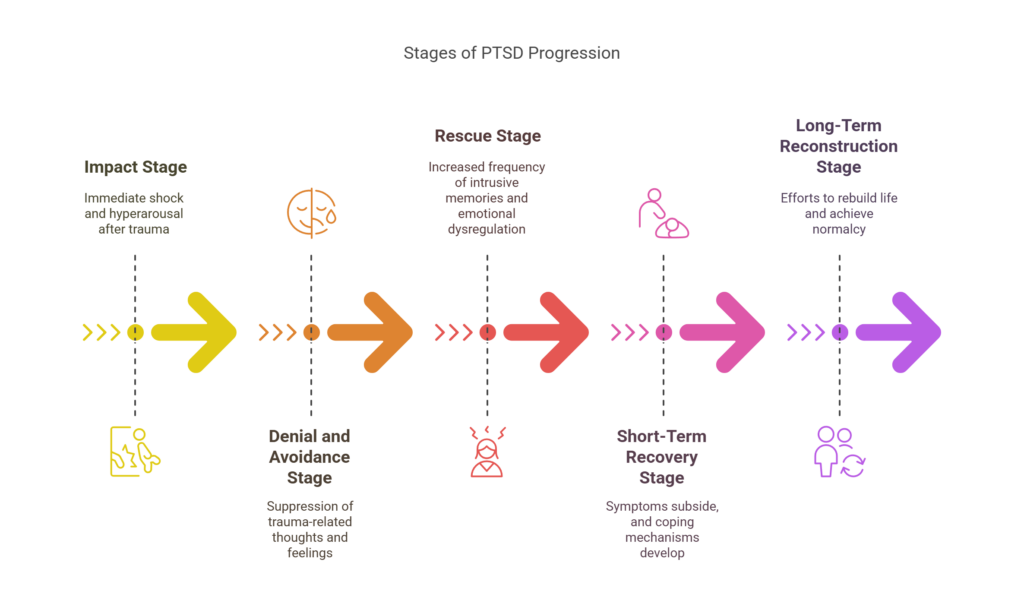Have you ever experienced a moment of intense fear, where your heart pounded in your chest and your breath caught in your throat? Perhaps it was a close call on the road, a frightening encounter with a stranger, or a sudden surge of anxiety during a presentation. While these moments of fear are common and often pass quickly, for individuals living with post-traumatic stress disorder (PTSD), these intense emotional reactions can become a constant presence, casting a shadow over their daily lives. PTSD is not simply a bad memory that lingers; it’s a complex condition that affects the way the brain processes information, leading to a range of distressing symptoms.
By delving into the stages of PTSD in Teens, and understanding what are the 5 stages of PTSD, we can gain a deeper understanding of this disorder and its profound impact on those who experience it learning effective coping mechanisms for managing panic attacks is crucial for embarking on the path to healing and reclaiming a sense of normalcy.
Moreover, learning effective coping mechanisms for managing PTSD panic attacks, a common and challenging aspect of this condition, is crucial for embarking on the path to healing and reclaiming a sense of normalcy. The journey through these stages, coupled with strategies to manage PTSD panic attacks, is a significant part of the process, offering hope and empowerment to individuals seeking relief from the heavy burden of PTSD.
Experiencing post-traumatic stress disorder (PTSD) can have a lasting impact on an individual’s life, bringing forth a variety of emotional and psychological challenges. If you’re wondering, “What are the 5 stages of PTSD,” understanding these stages becomes crucial in navigating this complex journey. By recognizing the different phases, individuals can gain insights into their own experiences and find effective ways to cope with the unique challenges that PTSD presents.

The impact or emergency stage of PTSD is the phase that occurs immediately following a traumatic event. This stage is characterized by a range of intense emotional and physical reactions, as the individual’s mind and body struggle to cope with the overwhelming experience.
Symptoms of the Impact or Emergency Stage
Following the immediate shock and distress of the impact or emergency stage, individuals often enter the denial or numbing stage of PTSD. This phase is characterized by a range of psychological mechanisms that serve as protective buffers against the overwhelming emotional and cognitive burden of the traumatic event.
Symptoms of the Denial/Numbing Stage
Emerging from the denial or numbing stage, individuals often enter the repetitive or intrusive stage of PTSD. This phase is characterized by the frequent and distressing intrusion of traumatic memories, leading to a sense of reliving the event repeatedly.
Symptoms of the Repetitive or Intrusive Stage
Emerging from the repetitive or intrusive stage of PTSD, individuals often enter the short-term recovery or intermediate stage. This phase is characterized by a gradual process of emotional and cognitive integration, as individuals begin to acknowledge the traumatic event and its impact on their lives while developing coping mechanisms to manage symptoms.
Symptoms of the Short-term Recovery or Intermediate Stage
Marking a significant turning point in the healing journey, individuals often enter the long-term reconstruction or recovery stage of PTSD. This phase is characterized by a deeper understanding of the trauma and its effects, the development of strategies to manage symptoms, and the reintegration into daily life.
Symptoms of the Long-term Reconstruction or Recovery Stage
Healing from PTSD is a journey, not a race. The journey, with its ebbs and flows, offers opportunities for introspection, growth, and the gradual reclamation of control over one’s life. With patience, perseverance, and self-compassion, individuals can navigate the complexities of PTSD and reclaim control over their lives.
Living with PTSD panic attacks can be challenging, but adopting effective strategies can make a significant difference. Here are practical approaches to help navigate and manage these intense moments:
Post-traumatic stress disorder (PTSD) is a complex and often debilitating condition that can leave individuals struggling to cope with the profound impact of traumatic experiences. Understanding the stages of PTSD, especially what are the 5 stages of PTSD, and learning to manage PTSD panic attacks are crucial steps in reclaiming control and finding a path to healing.
The journey through the stages of PTSD is like a roadmap to recovery, and managing panic attacks is a significant part of this process. The goal is not just to overcome, but to rediscover a sense of normalcy and embrace a future filled with fulfillment and meaning.
With a steadfast belief in one’s own strength, the support of those around us, and the insights provided in this comprehensive guide about the stages of PTSD and managing panic attacks, individuals can navigate the challenges of PTSD.
Ready to explore this journey to healing? What steps can you take today to better understand the stages of PTSD and equip yourself or support someone on this transformative path? Share your thoughts in the comments.
Stand with us in solidarity for teens coping with PTSD. Share your stories and discover valuable resources on our dedicated PTSD page. Let’s build a community of understanding and support.